Wondering how to make almond butter? Here’s your ultimate guide covering everything you need to know. You just need almonds and a food processor or a high speed blender. In about 10 minutes, you’ll have your own homemade almond butter at a fraction of the cost of store-bought.
I love using almond butter in desserts, especially in no-bake treats like these Vegan No-Bake Cookies and my favorite candy recipe, this Paleo Fudge. It also adds great flavor to my most popular recipe, these Paleo Chocolate Chip Cookies.
I go through huge amounts of nut butter when developing a recipe. There is no way I could afford to do that if I used store bought almond butter. So I learned to make almond butter early in my blogging days.
I toast them, let them cool a bit, throw them in the food processor and I have runny smooth almond butter at a fraction of the price of what I can find in stores or even online.
For a while I made almond butter in my high speed blender, but our neighbor actually complained to the supermarket. It apparently disturbed his peace. And his dog’s.
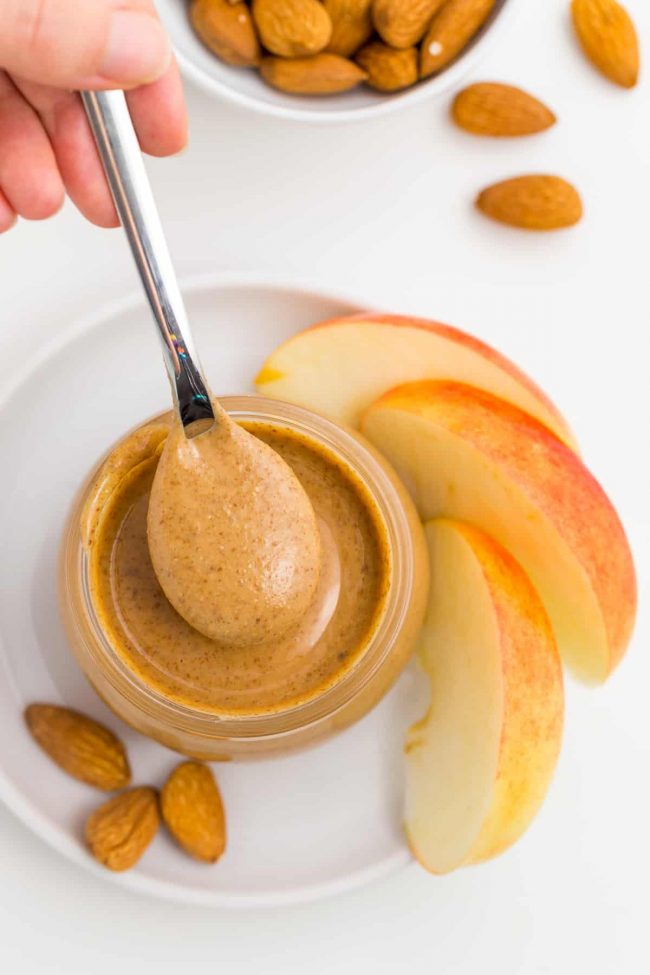
So now I take my food processor, go to the pantry, close the door and make almond butter.
You can do so much more with a food processor or the large jug of a blender like the Ninja I recommend below. Instead of using 1 1/2 cups of almonds, I can use more like 6.
Ingredients
You just need raw almonds! You can use pre-roasted or flavored almonds and skip the roasting step, but warm nuts are much faster and easier to process than room temperature nuts.
How to do it
Below you can see the stages.
- Whole, roasted and slightly cooled almonds
- Chopped almonds and then a dry powder, like almond flour
- A paste-like, thick mass
- Moveable, smooth almond butter!
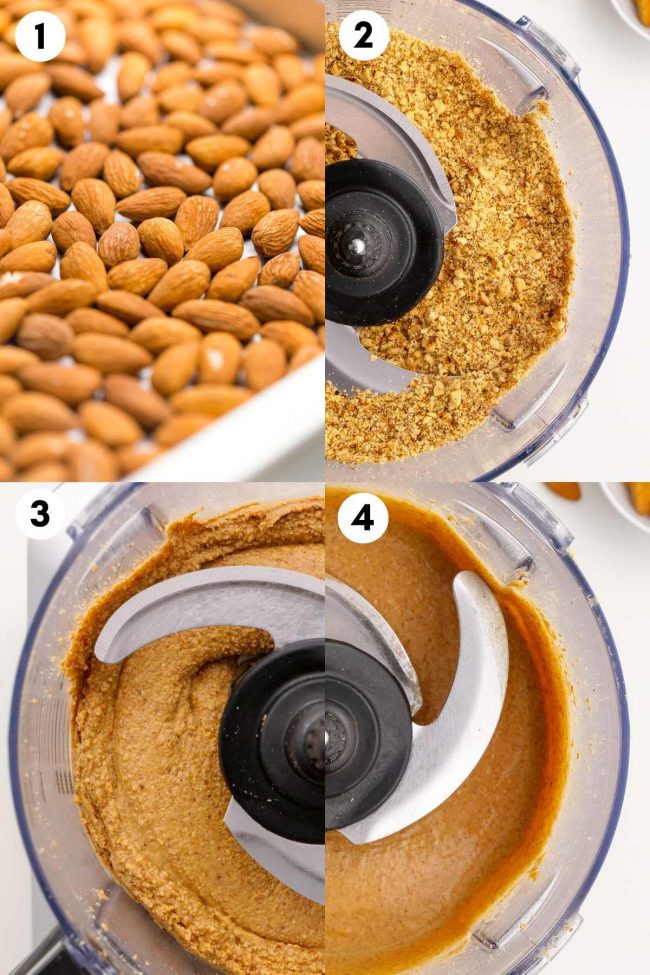
Return
1 1/2 cups (186 grams) of almonds yields 2/3 cup + 1 tablespoon (186 grams) of almond butter. So it’s a 2:1 ratio of almonds to almond butter.
That means if you need 1 cup of almond butter, you need to use 2 cups of almonds.
But this relationship is in volume only! If you need 400 grams of almond butter, use 400 grams of almonds.
Equipment
]
You need a food processor or a high-speed blender.
Food processor — a 1,000-watt processor will do the job. Before deciding which one to buy, I recommend reading the reviews and searching for “butter”. You can also search the FAQ section of Amazon’s product pages for “butter”. In the top sellers, someone usually already asks if nut butter can be made successfully with the food processor.
Mixer — a regular blender won’t work, and you’ll kill your blender. You need something like a Blendtec or Vitamix.
When I looked at food processors a few years ago, most recommended this Cuisinart for making nut butter.
It is currently $289 and came out in 2015. I wanted to find a newer and cheaper one.
These days, when you search for something like “best food processor to make nut butter,” you’ll find mostly AI-written articles on sites that only consist of AI-written articles.
So I recently spent an entire day trying to find the best affordable food processor for nut butter. So that rules out Vitamix and Blendtec.
I found this test where they (real real people! not robots) have tested tons of blenders and tested several different aspects including almond butter making performance. The Ninja got 9.5 out of 10.
There are some personal blenders that have single serving jars that are slightly better (I can’t imagine how though) at making almond butter, but the Ninja Foodi Power Pitcher System [CO351B, SS351] is the best option if you want a full-sized blender jar in addition to the smaller one designed for making nut butter. Right now it’s $159.99 but it was as low as $119 in April.
If you are in Europe I think this is the EU version.
Here you can see an overview of the other tests they did on the Ninja.
I was sold, so I bought one for my photographer and one for me. I am quite surprised by the results. The almond butter is as creamy as the nut butter I make with my Blendtec.
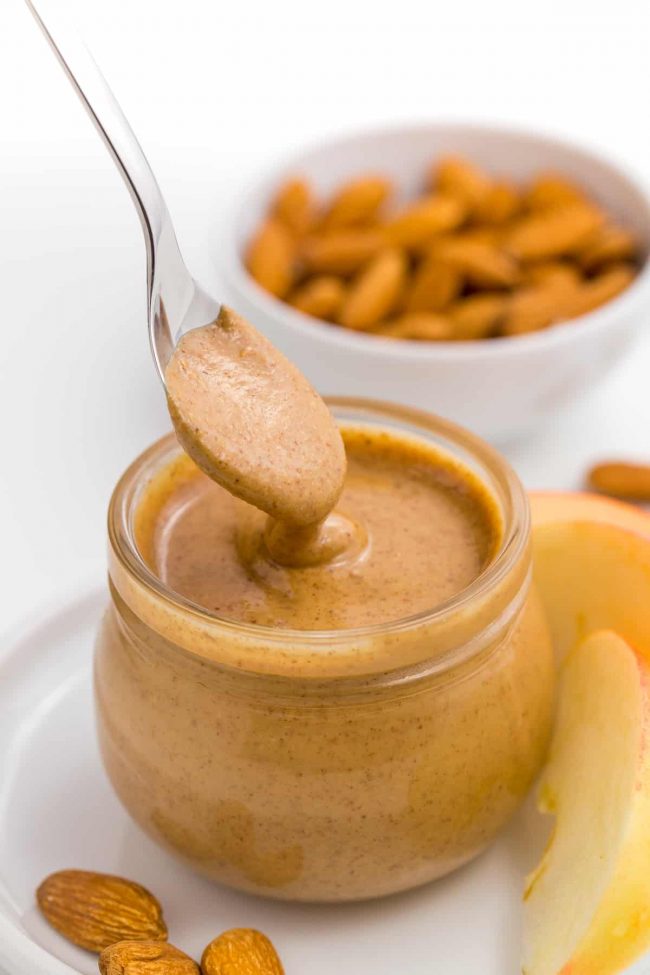
Questions?
I thought about all the possible questions that might come up when making almond butter. If I’m missing something, let me know!
Nuts:
- Can I use a different type of nuts?
For peanuts, read my post on how to make peanut butter. For walnuts, check out my walnut butter recipe. You can use the recipe below for pecans, hazelnuts and cashews, but you will probably need to adjust the cooking time. If you want to use hazelnuts, you’ll probably want to get rid of the hazelnut shells first.
The amount of time you have to process the nuts depends on the type of nut and your food processor or blender. Almonds take much longer than the aforementioned nuts.
- Do I have to roast the nuts?
If you want to make raw almond butter, I recommend finding a recipe for raw almond butter. I guess you have to add oil to get it completely smooth. When you roast nuts, you extract their oil, which makes processing much easier.
- How full should I fill the food processor? What if I only want a small amount?
If you don’t fill the processor enough, you won’t get anywhere. You need enough nuts so that the blade is completely covered, then add a few more.
Should you not need a lot of almond butter, then see the questions in the storage section below.
If you’re using a food processor, you’ll probably need to use 3 cups of almonds (or even more to cover the leaves if you have a large one).
If you are using the small jar in a high speed blender that is meant for making nut butter, there is a max line on the jar. You can fill nuts up to that line.
Add things to the almond butter:
- Can I add liquid things like honey, vanilla, etc.?
If you add anything liquid other than oil (which you don’t need!), the almond butter curdles. It will be clumsy and quite messed up. So don’t try it!
In this maple cinnamon almond butter recipe, I first roasted the nuts in maple syrup (so they were basically candied) and then added cinnamon after processing. And it’s incredibly good!
- Can I add spices and salt?
You can! If you want vanilla, use seeds from a vanilla pod. A little cinnamon is also good.
My recommendation is to make your almond butter, and when it’s your desired runny, pour some almond butter into a small bowl, add a little of what you want to add and see if it works. This is a much better way than adding something to your almond butter and ruining your whole batch!
- Don’t I need to add oil? Many other recipes say to add oil!
You don’t need a fancy new food processor to make almond butter. I used to use one from the former East Germany, which means it was really old. I have no idea why some recipes call for oil. Just keep processing, take breaks if needed and don’t give up!
See how runny my almond butter is? I have never needed oil to get this texture!
If you want to add oil you certainly can.
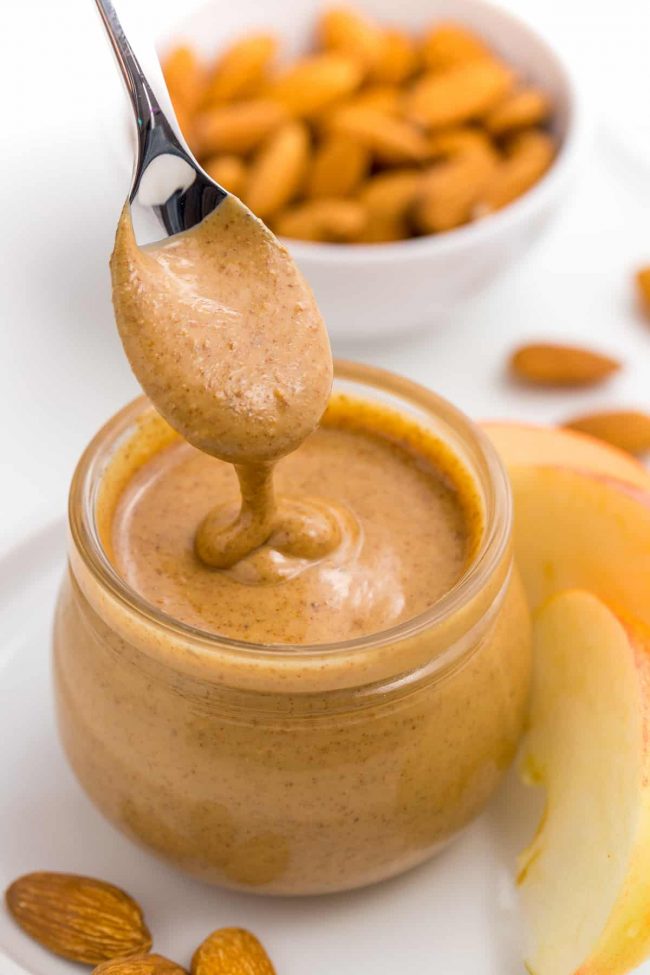
Storage:
- Does homemade almond butter have to be refrigerated?
Definitely cool it! The oil can go rancid. I read that you can store opened almond butter on the shelf for up to 3 months, but I don’t think I would recommend that, especially since homemade almond butter has no preservatives.
I don’t leave mine at room temperature for longer than 1 week. It’s just safer to refrigerate.
- How long does it stay good?
I’ve left my almond butter in the fridge for embarrassingly long periods of time without anything fishy happening to it. But I’m going to say 3 months to be on the safe side.
Also, make sure to always use a clean spoon. If you use something that was previously in jam, your mouth, whatever – your almond butter will mold in no time. And be sure not to use almonds that are about to expire if you want your almond butter to last a while.
- Can I freeze almond butter?
Yes! Up to 4-6 months. Be sure to use an airtight container.
- Does it separate like some natural almond butters?
I’ve had it happen a few times. When the jar is lost in the back of the refrigerator for six months, but even if it does not separate visibly, you should stir it before each use to ensure that the oil is evenly distributed.
- How will I know if it has gone bad?
You will be able to smell it. It will smell like oil paint, thinner or something like that. You will know! Throw it out immediately. And if you didn’t notice an odor but it tastes bitter, that also means it’s rancid and time to throw it away.
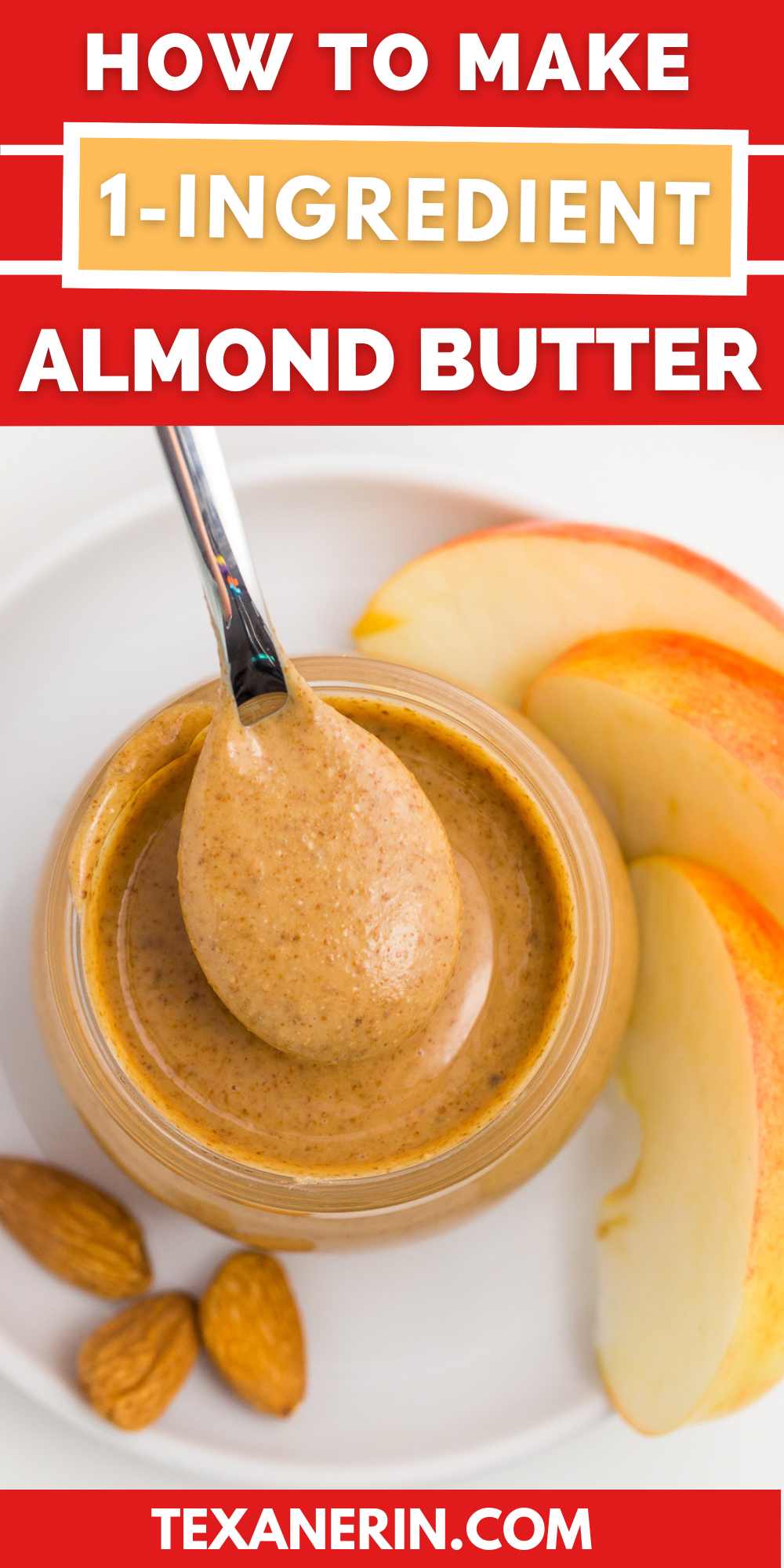
Troubleshooting:
- My almond butter won’t go together! What can I do and what did I do wrong?
Are you sure your food processor can make nut butter? If you are, you just need to be patient. Some food processors take longer than others.
Did you process the nuts while they were still warm but not hot? It helps the process along. Using room temperature almonds takes much longer. If your processor gets hot, take a break. Remove the bowl from the bottom, open the lid and leave for 10-20 minutes or until it has cooled quite a bit. We don’t want you to kill your food processor!
My favorite recipes with nut butter
In addition to the ones I listed at the beginning of the post, here are some other favorites.
I hope you will enjoy this almond butter! I would love to hear from you if you can make it. Feel free to leave a comment below or tag #texanerin on social media so I can see it. Thanks! 🙂
❀
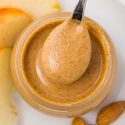
- Preparation day:
- Cooking time:
- Ready about:
- Return: 1 1/2 cups if using 3 cups almonds
Ingredients
- 1 1/2 cups (186 grams) raw almonds if using a small high-speed blender nut butter jar
- 3 cups (372 grams) or more raw almonds if using a food processor
- 1/4 to 1/2 teaspoon salt
Directions
- Preheat the oven to 350°F (175°C) and toast the almonds on a baking sheet for 8-12 minutes or until fragrant, stirring every 5 minutes.
- Let cool for just 5-10 minutes, then transfer nuts to food processor and process until creamy, scraping sides of bowl as needed, about 6 to 12 minutes. Do not overheat your food processor! Take breaks if your food processor starts to get too hot. In the first step, you have something that looks like almond flour. Then it becomes a thick mass. Then it breaks down into a liquid. After that, blend for another minute so that it is easy to pour.
- You will only be able to use about 1 1/2 cups of almonds. Roast the almonds according to the above instructions and let cool completely. Then use the smaller Twister jar (or equivalent – this is the smaller jar with a blade attached to the lid that you use to manually scrape the sides of the jar. This jar is for making nut butter.) and process on medium-high speed for 1-3 minutes. If your blender gets too hot, take breaks. Allow the blender and ground almonds to cool slightly if necessary, then blend again. Do not overheat your blender!
- Make sure it is room temperature or cold before using in a recipe.
- Refrigerate in an airtight container for up to 3 months.
For the food processor:
If using a high-speed blender such as a Blendtec or Vitamix:
Notes
- If you are using the small jar in a blender intended for making nut butter, there will be a max line on the jar. You can fill nuts up to that line. Usually it’s around 1 1/2 cups.
- If using a food processor, make sure the leaves are covered with almonds by about 1″ or 2.5 cm.
As an Amazon Associate, I earn on qualifying purchases. For more information, see my disclosure.

